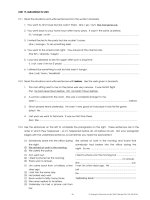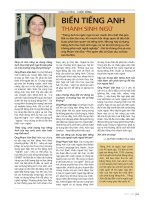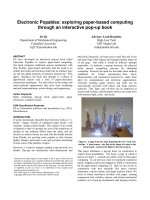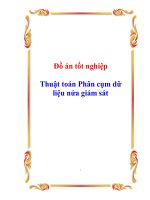[Tài liệu bằng Tiếng Anh] Ảo Thuật Toán Học - Mẹo tính nhẩm cực nhanh trong nháy mắt của Akash
Bạn đang xem bản rút gọn của tài liệu. Xem và tải ngay bản đầy đủ của tài liệu tại đây (629.25 KB, 168 trang )
The Secrets of Mental Math
Arthur T. Benjamin, Ph.D.
PUBLISHED BY:
THE GREAT COURSES
Corporate Headquarters
4840 Westfi elds Boulevard, Suite 500
Chantilly, Virginia 20151-2299
Phone: 1-800-832-2412
Fax: 703-378-3819
www.thegreatcourses.com
Copyright © The Teaching Company, 2011
Printed in the United States of America
This book is in copyright. All rights reserved.
Without limiting the rights under copyright reserved above,
no part of this publication may be reproduced, stored in
or introduced into a retrieval system, or transmitted,
in any form, or by any means
(electronic, mechanical, photocopying, recording, or otherwise),
without the prior written permission of
The Teaching Company.
i
Arthur T. Benjamin, Ph.D.
Professor of Mathematics
Harvey Mudd College
P
rofessor Arthur T. Benjamin is a Professor of
Mathematics at Harvey Mudd College. He
graduated from Carnegie Mellon University
in 1983, where he earned a B.S. in Applied
Mathematics with university honors. He received
his Ph.D. in Mathematical Sciences in 1989 from
Johns Hopkins University, where he was supported
by a National Science Foundation graduate fellowship and a Rufus P. Isaacs
fellowship. Since 1989, Professor Benjamin has been a faculty member of
the Mathematics Department at Harvey Mudd College, where he has served
as department chair. He has spent sabbatical visits at Caltech, Brandeis
University, and the University of New South Wales in Sydney, Australia.
In 1999, Professor Benjamin received the Southern California Section of
the Mathematical Association of America (MAA) Award for Distinguished
College or University Teaching of Mathematics, and in 2000, he received the
MAA Deborah and Franklin Tepper Haimo National Award for Distinguished
College or University Teaching of Mathematics. He was also named the
2006–2008 George Pólya Lecturer by the MAA.
Professor Benjamin’s research interests include combinatorics, game theory,
and number theory, with a special fondness for Fibonacci numbers. Many
of these ideas appear in his book (coauthored with Jennifer Quinn) Proofs
That Really Count: The Art of Combinatorial Proof, published by the MAA.
In 2006, that book received the MAA’s Beckenbach Book Prize. From 2004
to 2008, Professors Benjamin and Quinn served as the coeditors of Math
Horizons magazine, which is published by the MAA and enjoyed by more
than 20,000 readers, mostly undergraduate math students and their teachers.
In 2009, the MAA published Professor Benjamin’s latest book, Biscuits of
Number Theory, coedited with Ezra Brown.
ii
Professor Benjamin is also a professional magician. He has given more than
1000 “mathemagics” shows to audiences all over the world (from primary
schools to scienti¿ c conferences), in which he demonstrates and explains
his calculating talents. His techniques are explained in his book Secrets of
Mental Math: The Mathemagician’s Guide to Lightning Calculation and
Amazing Math Tricks. Proli¿ c math and science writer Martin Gardner calls
it “the clearest, simplest, most entertaining, and best book yet on the art of
calculating in your head.” An avid game player, Professor Benjamin was
winner of the American Backgammon Tour in 1997.
Professor Benjamin has appeared on dozens of television and radio programs,
including the Today show, The Colbert Report, CNN, and National Public
Radio. He has been featured in Scienti¿ c American, Omni, Discover, People,
Esquire, The New York Times, the Los Angeles Times, and Reader’s Digest.
In 2005, Reader’s Digest called him “America’s Best Math Whiz.” Ŷ
iii
Table of Contents
LECTURE GUIDES
INTRODUCTION
Professor Biography i
Course Scope 1
Acknowledgments 3
LECTURE 1
Math in Your Head! 4
LECTURE 2
Mental Addition and Subtraction 11
LECTURE 3
Go Forth and Multiply 21
LECTURE 4
Divide and Conquer 30
LECTURE 5
The Art of Guesstimation 35
LECTURE 6
Mental Math and Paper 41
LECTURE 7
Intermediate Multiplication 46
LECTURE 8
The Speed of Vedic Division 52
LECTURE 9
Memorizing Numbers 58
Table of Contents
iv
LECTURE 10
Calendar Calculating 63
LECTURE 11
Advanced Multiplication 69
LECTURE 12
Masters of Mental Math 76
SUPPLEMENTAL MATERIAL
Solutions 82
Timeline 150
Glossary 152
Bibliography 155
1
The Secrets of Mental Math
Scope:
M
ost of the mathematics that we learn in school is taught to us on
paper with the expectation that we will solve problems on paper.
But there is joy and lifelong value in being able to do mathematics
in your head. In school, learning how to do math in your head quickly and
accurately can be empowering. In this course, you will learn to solve many
problems using multiple strategies that reinforce number sense, which can
be helpful in all mathematics courses. Success at doing mental calculation
and estimation can also lead to improvement on several standardized tests.
We encounter numbers on a daily basis outside of school, including many
situations in which it is just not practical to pull out a calculator, from buying
groceries to reading the newspaper to negotiating a car payment. And as we
get older, research has shown that it is important to ¿ nd activities that keep
our minds active and sharp. Not only does mental math sharpen the mind,
but it can also be a lot of fun.
Our ¿ rst four lectures will focus on the nuts and bolts of mental math:
addition, subtraction, multiplication, and division. Often, we will see that
there is more than one way to solve a problem, and we will motivate many of
the problems with real-world applications.
Once we have mastery of the basics of mental math, we will branch out
in interesting directions. Lecture 5 offers techniques for easily ¿ nding
approximate answers when we don’t need complete accuracy. Lecture 6 is
devoted to pencil-and-paper mathematics but done in ways that are seldom
taught in school; we’ll see that we can simply write down the answer to a
multiplication, division, or square root problem without any intermediate
results. This lecture also shows some interesting ways to verify an answer’s
correctness. In Lecture 7, we go beyond the basics to explore advanced
multiplication techniques that allow many large multiplication problems to
be dramatically simpli¿ ed.
Scope
2
In Lecture 8, we explore long division, short division, and Vedic division,
a fascinating technique that can be used to generate answers faster than
any method you may have seen before. Lecture 9 will teach you how to
improve your memory for numbers using a phonetic code. Applying this
code allows us to perform even larger mental calculations, but it can also be
used for memorizing dates, phone numbers, and your favorite mathematical
constants. Speaking of dates, one of my favorite feats of mental calculation
is being able to determine the day of the week of any date in history. This is
actually a very useful skill to possess. It’s not every day that someone asks
you for the square root of a number, but you probably encounter dates every
day of your life, and it is quite convenient to be able to ¿ gure out days of the
week. You will learn how to do this in Lecture 10.
In Lecture 11, we venture into the world of advanced multiplication; here,
we’ll see how to square 3- and 4-digit numbers, ¿ nd approximate cubes of
2-digit numbers, and multiply 2- and 3-digit numbers together. In our ¿ nal
lecture, you will learn how to do enormous calculations, such as multiplying
two 5-digit numbers, and discuss the techniques used by other world-
record lightning calculators. Even if you do not aspire to be a grandmaster
mathemagician, you will still bene¿ t tremendously by acquiring the skills
taught in this course. Ŷ
Acknowledgments
P
utting this course together has been extremely gratifying, and there
are several people I wish to thank. It has been a pleasure working with
the very professional staff of The Great Courses, including Lucinda
Robb, Marcy MacDonald, Zachary Rhoades, and especially Jay Tate. Thanks
to Professor Stephen Lucas, who provided me with valuable historical
information, and to calculating protégés Ethan Brown and Adam Varney
for proof-watching this course. Several groups gave me the opportunity to
practice these lectures for live audiences, who provided valuable feedback.
In particular, I am grateful to the North Dakota Department of Public
Instruction, Professor Sarah Rundell of Dennison University, Dr. Daniel
Doak of Ohio Valley University, and Lisa Loop of the Claremont Graduate
University Teacher Education Program.
Finally, I wish to thank my daughters, Laurel and Ariel, for their patience
and understanding and, most of all, my wife, Deena, for all her assistance
and support during this project.
Arthur Benjamin
Claremont, California
3
4
Lecture 1: Math in Your Head!
Math in Your Head!
Lecture 1
Just by watching this course, you will learn all the techniques that are
required to become a fast mental calculator, but if you want to actually
improve your calculating abilities, then just like with any skill, you
need to practice.
I
n school, most of the math we learn is done with pencil and paper, yet in
many situations, it makes more sense to do problems in your head. The
ability to do rapid mental calculation can help students achieve higher
scores on standardized tests and can keep the mind sharp as we age.
One of the ¿ rst mental math tips you can practice is to calculate from left
to right, rather than right to left. On paper, you might add 2300 + 45 from
right to left, but in your head, it’s more natural and faster to add from left
to right.
These lectures assume that you know the multiplication table, but there are
some tricks to memorizing it that may be of interest to parents and teachers.
I teach students the multiples of 3, for example, by ¿ rst having them practice
counting by 3s, then giving them
the multiplication problems in
order (3 × 1, 3 × 2 …) so that they
associate the problems with the
counting sequence. Finally, I mix
up the problems so that the students
can practice them out of sequence.
There’s also a simple trick to
multiplying by 9s: The multiples of
9 have the property that their digits add up to 9 (9 × 2 = 18 and 1 + 8 = 9).
Also, the ¿ rst digit of the answer when multiplying by 9 is 1 less than the
multiplier (e.g., 9 × 3 = 27 begins with 2).
The ability to do rapid mental
calculation can help students
achieve higher scores on
standardized tests and can
keep the mind sharp as we age.
5
In many ways, mental calculation is a process of simpli¿ cation. For example,
the problem 432 × 3 sounds hard, but it’s the sum of three easy problems:
3 × 400 = 1200, 3 × 30 = 90, and 3 × 2 = 6; 1200 + 90 + 6 = 1296. Notice
that when adding the numbers, it’s easier to add from largest to smallest,
rather than smallest to largest.
Again, doing mental calculations from left to right is also generally easier
because that’s the way we read numbers. Consider 54 × 7. On paper, you
might start by multiplying 7 × 4 to get 28, but when doing the problem
mentally, it’s better to start with 7 × 50 (350) to get an estimate of the answer.
To get the exact answer, add the product of 7 × 50 and the product of 7 × 4:
350 + 28 = 378.
Below are some additional techniques that you can start using right away:
x The product of 11 and any 2-digit number begins and ends with the
two digits of the multiplier; the number in the middle is the sum of
the original two digits. Example: 23 × 11 ĺ 2 + 3 = 5; answer: 253.
For a multiplier whose digits sum to a number greater than 9, you
have to carry. Example: 85 × 11 ĺ 8 + 5 = 13; carry the 1 from 13
to the 8; answer: 935.
x The product of 11 and any 3-digit number also begins and ends
with the ¿ rst and last digits of the multiplier, although the ¿ rst
digit can change from carries. In the middle, insert the result of
adding the ¿ rst and second digits and the second and third digits.
Example: 314 × 11 ĺ 3 + 1 = 4 and 1 + 4 = 5; answer: 3454.
x To square a 2-digit number that ends in 5, multiply the ¿ rst
digit in the number by the next higher digit, then attach 25 at
the end. Example: 35
2
ĺ 3 × 4 = 12; answer: 1225. For 3-digit
numbers, multiply the ¿ rst two numbers together by the next
higher number, then attach 25. Example: 305
2
ĺ 30 × 31 = 930;
answer: 93,025.
6
Lecture 1: Math in Your Head!
x To multiply two 2-digit numbers that have the same ¿ rst digits
and last digits that sum to 10, multiply the ¿ rst digit by the next
higher digit, then attach the product of the last digits in the original
two numbers. Example: 84 × 86 ĺ 8 × 9 = 72 and 4 × 6 = 24;
answer: 7224.
x To multiply a number between 10 and 20 by a 1-digit number,
multiply the 1-digit number by 10, then multiply it by the second
digit in the 2-digit number, and add the products. Example: 13 × 6
ĺ (6 × 10) + (6 × 3) = 60 + 18; answer: 78.
x To multiply two numbers that are both between 10 and 20, add the
¿ rst number and the last digit of the second number, multiply the
result by 10, then add that result to the product of the last digits in
both numbers of the original problem. Example: 13 × 14 ĺ 13 + 4
= 17, 17 × 10 = 170, 3 × 4 = 12, 170 + 12 = 182; answer: 182. Ŷ
left to right: The “right” way to do mental math.
right to left: The “wrong” way to do mental math.
Benjamin and Shermer, Secrets of Mental Math: The Mathemagician’s Guide
to Lightning Calculation and Amazing Math Tricks, chapter 0.
Hope, Reys, and Reys, Mental Math in the Middle Grades.
Julius, Rapid Math Tricks and Tips: 30 Days to Number Power.
Ryan, Everyday Math for Everyday Life: A Handbook for When It Just
Doesn’t Add Up.
Important Terms
Suggested Reading
7
The following mental addition and multiplication problems can be done
almost immediately, just by listening to the numbers from left to right.
1. 23 + 5
2. 23 + 50
3. 500 + 23
4. 5000 + 23
5. 67 + 8
6. 67 + 80
7. 67 + 800
8. 67 + 8000
9. 30 + 6
10. 300 + 24
11. 2000 + 25
12. 40 + 9
13. 700 + 84
14. 140 + 4
15. 2500 + 20
16. 2300 + 58
Problems
8
Lecture 1: Math in Your Head!
17. 13 × 10
18. 13 × 100
19. 13 × 1000
20. 243 × 10
21. 243 × 100
22. 243 × 1000
23. 243 × 1 million
24. Fill out the standard 10-by-10 multiplication table as quickly as you
can. It’s probably easiest to ¿ ll it out one row at a time by counting.
25. Create an 8-by-9 multiplication table in which the rows represent
the numbers from 2 to 9 and the columns represent the numbers
from 11 to 19. For an extra challenge, ¿ ll out the squares in
random order.
26. Create the multiplication table in which the rows and columns
represent the numbers from 11 to 19. For an extra challenge, ¿ ll out
the rows in random order. Be sure to use the shortcuts we learned in
this lecture, including those for multiplying by 11.
The following multiplication problems can be done just by listening to the
answer from left to right.
27. 41 × 2
28. 62 × 3
29. 72 × 4
30. 52 × 8
9
31. 207 × 3
32. 402 × 9
33. 543 × 2
Do the following multiplication problems using the shortcuts from
this lecture.
34. 21 × 11
35. 17 × 11
36. 54 × 11
37. 35 × 11
38. 66 × 11
39. 79 × 11
40. 37 × 11
41. 29 × 11
42. 48 × 11
43. 93 × 11
44. 98 × 11
45. 135 × 11
46. 261 × 11
47. 863 × 11
10
Lecture 1: Math in Your Head!
48. 789 × 11
49. Quickly write down the squares of all 2-digit numbers that end in 5.
50. Since you can quickly multiply numbers between 10 and 20, write
down the squares of the numbers 105, 115, 125, … 195, 205.
51. Square 995.
52. Compute 1005
2
.
Exploit the shortcut for multiplying 2-digit numbers that begin with the same
digit and whose last digits sum to 10 to do the following problems.
53. 21 × 29
54. 22 × 28
55. 23 × 27
56. 24 × 26
57. 25 × 25
58. 61 × 69
59. 62 × 68
60. 63 × 67
61. 64 × 66
62. 65 × 65
Solutions for this lecture begin on page 82.
11
Mental Addition and Subtraction
Lecture 2
The bad news is that most 3-digit subtraction problems require some
sort of borrowing. But the good news is that they can be turned into
easy addition problems.
W
hen doing mental addition, we work one digit at a time. To add a
1-digit number, just add the 1s digits (52 + 4 ĺ 2 + 4 = 6, so 52 +
4 = 56). With 2-digit numbers, ¿ rst add the 10s digits, then the 1s
digits (62 + 24 ĺ 62 + 20 = 82 and 82 + 4 = 86).
With 3-digit numbers, addition is easy when one or both numbers are
multiples of 100 (400 + 567 = 967) or when both numbers are multiples of
10 (450 + 320 ĺ 450 + 300 = 750 and 750 + 20 = 770). Adding in this way
is useful if you’re counting calories.
To add 3-digit numbers, ¿ rst add the 100s, then the 10s, then the 1s. For 314
+ 159, ¿ rst add 314 + 100 = 414. The problem is now simpler, 414 + 59;
keep the 400 in mind and focus on 14 + 59. Add 14 + 50 = 64, then add 9 to
get 73. The answer to the original problem is 473.
We could do 766 + 489 by adding the 100s, 10s, and 1s digits, but each
step would involve a carry. Another way to do the problem is to notice that
489 = 500 – 11; we can add 766 + 500, then subtract 11 (answer: 1255).
Addition problems that involve carrying can often be turned into easy
subtraction problems.
With mental subtraction, we also work one digit at a time from left to right.
With 74 – 29, ¿ rst subtract 74 – 20 = 54. We know the answer to 54 – 9 will
be 40-something, and 14 – 9 = 5, so the answer is 45.
A subtraction problem that would normally involve borrowing can usually
be turned into an easy addition problem with no carrying. For 121 – 57,
subtract 60, then add back 3: 121 – 60 = 61 and 61 + 3 = 64.
12
Lecture 2: Mental Addition and Subtraction
With 3-digit numbers, we again subtract the 100s, the 10s, then the 1s. For
846 – 225, ¿ rst subtract 200: 846 – 200 = 646. Keep the 600 in mind, then do
46 – 25 by subtracting 20, then subtracting 5: 46 – 20 = 26 and 26 – 5 = 21.
The answer is 621.
Three-digit subtraction problems can often be turned into easy addition
problems. For 835 – 497, treat 497 as 500 – 3. Subtract 835 – 500, then add
back 3: 835 – 500 = 335 and 335 + 3 = 338.
Understanding complements helps in doing dif¿ cult subtraction. The
complement of 75 is 25 because 75 + 25 = 100. To ¿ nd the complement
of a 2-digit number, ¿ nd the
number that when added to the
¿ rst digit will yield 9 and the
number that when added to the
second digit will yield 10. For
75, notice that 7 + 2 = 9 and
5 + 5 = 10. If the number ends in 0, such as 80, then the complement will
also end in 0. In this case, ¿ nd the number that when added to the ¿ rst digit
will yield 10 instead of 9; the complement of 80 is 20.
Knowing that, let’s try 835 – 467. We ¿ rst subtract 500 (835 – 500 = 335),
but then we need to add back something. How far is 467 from 500, or how
far is 67 from 100? Find the complement of 67 (33) and add it to 335:
335 + 33 = 368.
To ¿ nd 3-digit complements, ¿ nd the numbers that will yield 9, 9, 10 when
added to each of the digits. For example, the complement of 234 is 766.
Exception: If the original number ends in 0, so will its complement, and the
0 will be preceded by the 2-digit complement. For example, the complement
of 670 will end in 0, preceded by the complement of 67, which is 33; the
complement of 670 is 330.
Three-digit complements are used frequently in making change. If an
item costs $6.75 and you pay with a $10 bill, the change you get will be
the complement of 675, namely, 325, $3.25. The same strategy works with
change from $100. What’s the change for $23.58? For the complement of
Understanding complements helps
in doing dif¿ cult subtraction.
13
2358, the digits must add to 9, 9, 9, and 10. The change would be $76.42.
When you hear an amount like $23.58, think that the dollars add to 99 and
the cents add to 100. With $23.58, 23 + 76 = 99 and 58 + 42 = 100. When
making change from $20, the idea is essentially the same, but the dollars add
to 19 and the cents add to 100.
As you practice mental addition and subtraction, remember to work one
digit at a time and look for opportunities to use complements that turn hard
addition problems into easy subtraction problems and vice versa. Ŷ
complement: The distance between a number and a convenient round
number, typically, 100 or 1000. For example, the complement of 43 is 57
since 43 + 57 = 100.
Benjamin and Shermer, Secrets of Mental Math: The Mathemagician’s Guide
to Lightning Calculation and Amazing Math Tricks, chapter 1.
Julius, More Rapid Math Tricks and Tips: 30 Days to Number Mastery.
———, Rapid Math Tricks and Tips: 30 Days to Number Power.
Kelly, Short-Cut Math.
Because mental addition and subtraction are the building blocks to all mental
calculations, plenty of practice exercises are provided. Solve the following
mental addition problems by calculating from left to right. For an added
challenge, look away from the numbers after reading the problem.
1. 52 + 7
2. 93 + 4
Important Term
Suggested Reading
Problems
14
Lecture 2: Mental Addition and Subtraction
3. 38 + 9
4. 77 + 5
5. 96 + 7
6. 40 + 36
7. 60 + 54
8. 56 + 70
9. 48 + 60
10. 53 + 31
11. 24 + 65
12. 45 + 35
13. 56 + 37
14. 75 + 19
15. 85 + 55
16. 27 + 78
17. 74 + 53
18. 86 + 68
19. 72 + 83
15
Do these 2-digit addition problems in two ways; make sure the second way
involves subtraction.
20. 68 + 97
21. 74 + 69
22. 28 + 59
23. 48 + 93
Try these 3-digit addition problems. The problems gradually become more
dif¿ cult. For the harder problems, it may be helpful to say the problem out
loud before starting the calculation.
24. 800 + 300
25. 675 + 200
26. 235 + 800
27. 630 + 120
28. 750 + 370
29. 470 + 510
30. 980 + 240
31. 330 + 890
32. 246 + 810
33. 960 + 326
16
Lecture 2: Mental Addition and Subtraction
34. 130 + 579
35. 325 + 625
36. 575 + 675
37. 123 + 456
38. 205 + 108
39. 745 + 134
40. 341 + 191
41. 560 + 803
42. 566 + 185
43. 764 + 637
Do the next few problems in two ways; make sure the second way
uses subtraction.
44. 787 + 899
45. 339 + 989
46. 797 + 166
47. 474 + 970
Do the following subtraction problems from left to right.
48. 97 – 6
49. 38 – 7
17
50. 81 – 6
51. 54 – 7
52. 92 – 30
53. 76 – 15
54. 89 – 55
55. 98 – 24
Do these problems two different ways. For the second way, begin by
subtracting too much.
56. 73 – 59
57. 86 – 68
58. 74 – 57
59. 62 – 44
Try these 3-digit subtraction problems, working from left to right.
60. 716 – 505
61. 987 – 654
62. 768 – 222
63. 645 – 231
64. 781 – 416
18
Lecture 2: Mental Addition and Subtraction
Determine the complements of the following numbers, that is, their distance
from 100.
65. 28
66. 51
67. 34
68. 87
69. 65
70. 70
71. 19
72. 93
Use complements to solve these problems.
73. 822 – 593
74. 614 – 372
75. 932 – 766
76. 743 – 385
77. 928 – 262
78. 532 – 182
79. 611 – 345
80. 724 – 476
19
Determine the complements of these 3-digit numbers, that is, their distance
from 1000.
81. 772
82. 695
83. 849
84. 710
85. 128
86. 974
87. 551
Use complements to determine the correct amount of change.
88. $2.71 from $10
89. $8.28 from $10
90. $3.24 from $10
91. $54.93 from $100
92. $86.18 from $100
93. $14.36 from $20
94. $12.75 from $20
95. $31.41 from $50









